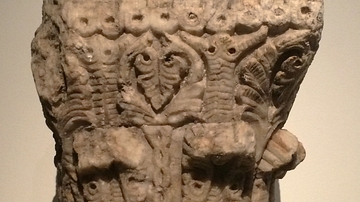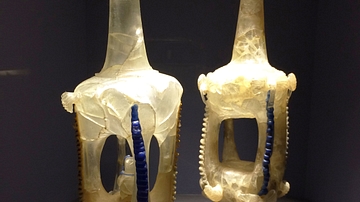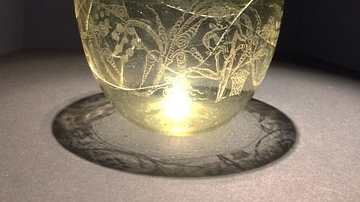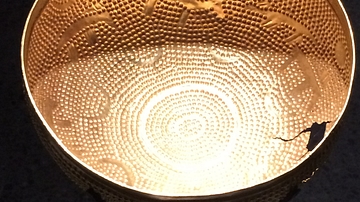Search Images
Browse Content (p. 1217)

Image
Syrian Column Capital
The half-palmettes on this column capital made from marble are ultimately derived from ancient Assyrian models. Stylization transforms its more recent Hellenistic predecessors. This specimen dates from the late 7th-early 8th century CE. (Aga...

Image
Head of a Bodhisattva from China's Sui Dynasty
This a picture of the head of a statue of a bodhisattva, which was made in Henan Province of sandstone and gilt during the Sui Dynasty (581-618 CE). (Royal Ontario Museum, Toronto)

Image
Ancient Chinese Tiger Bone
At roughly 22 cm (9 in) in length and containing 22 Chinese characters, this tiger bone was made in the third year of Emperor Dixin (fl. c. 1152 BCE) of the Shang Dynasty (c.1600-1046 BCE). (Royal Ontario Museum, Toronto)

Image
Tomb Entrance from Han Dynasty China
Until about the 2nd century BCE, Chinese tombs featured chambers made of heavy wooden logs. Thereafter, tombs were made of stone and brick. This stone-made example from the Han Dynasty (206 BCE-220 CE) makes clear that the tombs of the wealthy...

Image
Bottles with Four Tubes from Roman Cologne and Trier
Four tubes are connected to the upper and lower portions of these ancient Roman glass bottles. The tubes were created by carefully cutting and bending the body of a free-blown glass bottle. Like similar piece from Trier, the Cologne bottle...

Image
A Roman Beaker for Merueifa
A dedication is incised on the rim of this Roman beaker made of glass: "MERVEIFA VIVAS TVIS." (Translation from Latin: "Merueifa, may you live among your own.") Beneath the inscription are naked, winged boys harvesting grapes, watched by...

Image
Memorial to Deceased Roman Cavalryman
All that remains of this stone memorial is a portrait of the deceased Roman cavalryman. The prototype of this kind of portrait can be traced to Hellenistic Greece. This memorial was found in Cologne, Germany and dates from the 1st century...

Image
Zurich-Altstetten Bowl
Discovered during the construction of a railway line in 1906 in Switzerland, this golden bowl weighs 910 g, making it one of the heaviest gold receptacles unearthed in Europe to date. It was created around 1500-1000 BCE. (Landesmuseum, Zürich...

Image
Ancient Egyptian Relief of Working Men
This ancient Egtyptian relief of two men pulling a rope is made from stone and dates from the Intermedite Period or the Early Middle Kingdom (c. 2100-1940 BCE). It originally belonged to a necropolis and was found at Herakleopolis Magna (Ihnasya...

Image
Hispano-Roman Marble Mask
This Hispano-Roman tragedy mask was originally an architectural element made of marble. It dates from the 1st-2nd century CE, and it was found at Bañuelas (Ávila), Spain. (Museo Arqueológico Nacional, Madrid)